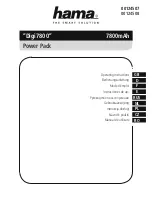
3
9. SECURE WORK.
Use clamps or
a vise to hold work. It’s safer than
using your hand and it frees both
hands to operate tool.
10. DON’T OVERREACH.
Keep proper
footing and balance at all times.
11. MAINTAIN TOOLS WITH CARE.
Keep tools clean and sharp for
better and safe performance.
Follow instructions for lubricating
and changing accessories. Keep
handles dry, clean, and free from oil
and grease.
12. DISCONNECT TOOLS WHEN
NOT IN USE,
before servicing, and
when changing accessories such as
sockets and attachments.
13. AVOID UNINTENTIONAL START-
ING.
Don’t carry tool with finger on
switch.
14. STAY ALERT
Watch what you are
doing. Use common sense. Do not
operate tool when you are tired.
15. CHECK DAMAGED PARTS.
Be-
fore further use of the tool, a guard
or other part that is damaged should
be carefully checked to determine
that it will operate properly and per-
form its intended function. Check for
alignment of moving parts, binding
of moving parts, breakage of parts,
mounting, and any other condi-
tions that may affect its operation. A
guard or other part that is damaged
should be properly repaired or
replaced by an authorized service
center unless otherwise indicated
elsewhere in this manual. Have
defective switches replaced by au-
thorized service center. Do not use
tool if switch does not turn it on and
off.
16. BE AWARE
that this tool is always
in an operating condition because it
does not have to be plugged into an
electrical outlet.
17. NEVER TOUCH THE MOVING
PARTS
such as sockets and attach-
ments.
18. DO NOT WIPE PLASTIC PARTS
WITH SOLVENTS.
Solvents such
as gasoline, thinner, benzene, car-
bon tetrachloride, and alcohol may
damage and crack the plastic parts.
Wipe the plastic parts with a soft
cloth lightly dampened with soapy
water.
7. PORTEZ DES VÊTEMENTS AP-
PROPRIÉS.
Ne portez ni vêtements
amples ni bijoux. Ils pourraient être
entraînés par les pièces mobiles.
8. UTILISEZ UN MASQUE QUI
RECOUVRE VOTRE VISAGE OU
UN MASQUE CONTRE LA POUS-
SIÈRE
si le fonctionnement ou
l’environnement est poussiéreux.
9. FIXEZ VOTRE TRAVAIL.
Utilisez
des brides ou un étau pour tenir
votre travail. Ceci est plus sûr que
d’utiliser votre main, et libère vos
deux mains pour faire fonctionner
l’outil.
10. NE TENDEZ PAS TROP LOIN
L’OUTIL.
Gardez toujours l’équilibre
et une bonne position des pieds.
11. FAITES SOIGNEUSEMENT LA
MAINTENANCE DES OUTILS.
Gardez les outils propres et bien
aiguisés pour qu’ils fonctionnent
bien et sans danger. Suivez les
instructions pour le graissage et
le changement des accessoires.
S’assurez que les poignées soient
sèches, propres, et sans huile ni
graisse.
12. DÉBRANCHEZ LES OUTILS QUI
NE SONT PAS UTILISÉS,
avant
tout entretien ou toute réparation,
et lors du changement des acces-
soires tels que les barils et les fixa
-
tions.
13. ÉVITER TOUT DÉMARRAGE IN-
VOLONTAIRE.
Ne portez pas l’outil
avec votre doigt sur l’interrupteur.
14. RESTEZ VIGILANT.
Faites atten-
tion à ce que vous faites. Utilisez
votre bon sens. Ne faites pas
marcher l’outil si vous êtes fatigué.
15. VÉRIFIEZ LES PIÈCES ENDOM-
MAGÉES.
Avant une nouvelle
utilisation de l’outil, vérifiez avec
soin toute protection ou toute
pièce qui est endommagée afin de
déterminer si elle peut fonctionner
correctement et exécuter sa fonc
-
tion. Vérifier s’il y a un alignement
des parties mobiles, un blocage de
celles-ci, une rupture des pièces,
un assemblage, ou n’importe quelle
autre condition qui pourrait modifier
le fonctionnement de l’outil.
16. CONSIDÉREZ
que cet outil est
toujours en état de fonctionnement
car il n’a pas besoin d’être branché
à une prise de courant.
17. NE TOUCHEZ JAMAIS LES PAR-
TIES MOBILES
telles que les barils
et les fixations.
18. N’ESSUYEZ PAS LES PIÈCES
EN PLASTIQUE AVEC DES
7. LLEVE ROPA APROPIADA.
No
lleve ropa suelta ni joyas. Podría
engancharse en las partes que se
mueven.
8. USE UNA MASCARA CONTRA
EL POLVO O UNA MASCARA
FACIAL
si la zona de operación o
el entorno es polvoriento.
9. ASEGURE EL TRABAJO.
Use
abrazaderas o tornillos de banco
para asegurar el trabajo. Son
más seguras que usar la mano y
permiten que las dos manos estén
libres para operar la herramienta.
10. NO UTILICE LA MAQUINA COMO
APOYO.
Manténgase siempre en
un equilibrio estable y con los pies
bien plantados en el suelo.
11. MANTENGA LAS HERRAMIEN-
TAS CON CUIDADO.
Mantenga
las herramientas en condiciones
limpias y afiladas para obtener un
rendimiento mejor y seguro. Siga
las instrucciones para lubricar y
cambiar los accesorios. Mantenga
los mangos secos, limpios y sin
aceite o grasa.
12. DESCONECTE LAS HERRA-
MIENTAS CUANDO NO SE USAN,
antes de darles mantenimiento y
cuando se cambien los accesorios,
como las agarraderas y conexio
-
nes.
13. EVITE LOS ARRANQUES NO
INTENCIONALES.
No lleve la her-
ramienta con el dedo puesto sobre
el interruptor.
14. MANTENGASE ALERTA.
Mire lo
que hace. Use el sentido común.
No opere la herramienta cuando
esté cansado.
15. INSPECCIONE LAS PARTES
DAÑADAS.
Antes de usar más
la herramienta, se deben inspec-
cionar las guardas u otras partes
para determinar que funcionan
correctamente y que realizan las
funciones para las cuales fueron
hechas. Compruebe el alineamiento
y las conexiones de las partes
que se mueven, la rotura de las
partes, el montaje y cualquier otra
condición que pueda afectar a la
operación. A menos que se indique
de otra manera en este manual,
una guarda u otra parte que esté
dañada debe ser reparada o susti-
tuida apropiadamente por un centro
de servicios autorizado. Haga que
un centro de servicios autorizado
sustituya los interruptores defec-
tuosos. No use la herramienta si el
interruptor no se enciende ni apaga.
16. TENGA EN CUENTA
que esta her-
































